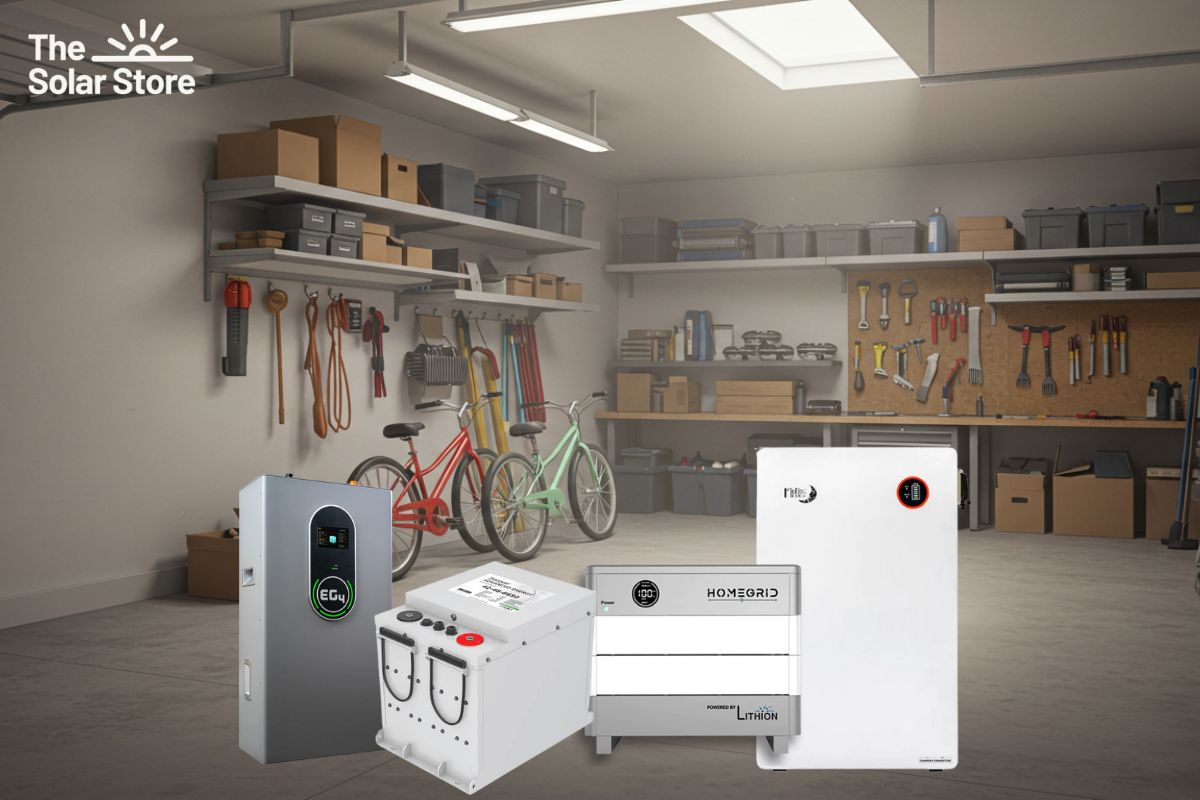When setting up an off-grid solar system, the choice of energy storage is just as important as the solar panels themselves. Without a reliable battery to store energy, your solar system becomes nothing more than a power source during daylight hours.
In recent years, lithium iron phosphate (LiFePO4) batteries have become the go-to option for off-grid solar setups, thanks to their longevity, efficiency, and safety. Still, depending on your configuration, some models are worth investing in more than others.
In this article, we’ll explain some of the best lithium batteries on the market and evaluate their suitability for various off-grid needs, starting with the top customer’s favourite: the EG4 14.3 kWh Indoor WallMount.
What are the Best Batteries for Off-Grid Solar Systems?
Indeed, the most commonly used batteries for solar and other renewable systems are lead-acid batteries. They store energy using lead plates in a liquid acid solution. These batteries are big and heavy, but cheaper and easier to find than most other options.
However, this buying guide focuses on Lithium-ion batteries for good reasons.
-
They’re much smaller and lighter than the lead-acid equivalent, and they can charge and discharge faster without quickly wearing out.
-
Although they cost more, lithium batteries are a smart choice when saving space or reducing transport weight really matters.
1. EG4 14.3 kWh Indoor WallMount (48V, 280Ah)
Price: $3,299
Key Features:
-
14.3 kWh capacity
-
48V
-
280Ah
-
Built for indoor use
-
Energy-efficient and long lifespan.
BUY IF…
Unsurprisingly, this particular model has become the top customer’s favourite. EG4 14.3 kWh Indoor WallMount is an excellent choice for off-grid solar systems because it stores a lot of energy (14.3 kWh), enough to power essentials like lights, fans, fridge, and even small appliances overnight.
Its wall-mount design saves indoor space and works well with 48V systems. This is a solid buy if you want strong backup power and energy independence.
2. EG4 14.3 kWh PowerPro Wall Mount AllWeather (48V, 280Ah)
Price: $3,999
Key Features:
-
14.3 kWh capacity
-
48V
-
280Ah
-
All-weather design for outdoor use
-
High energy output.
BUY IF…
The EG4 14.3 kWh PowerPro Wall Mount All-Weather Battery is perfect for installing outdoors or in places with harsh weather. It’s built to handle rain, dust, and even freezing temperatures, thanks to its weatherproof casing (IP65-rated) and built-in heater that keeps it working even when it’s really cold.
It also has smart safety features like fire protection and an emergency stop button. Its touchscreen makes it easy to check status, and setup is simple with its quick-connect cables.
3. EG4 LL-S 5.12Kwh Server Rack Battery (48V, 100Ah)
Price: $1,329
Key Features:
-
5.12 kWh capacity
-
48V, 100Ah
-
Perfect for server rack installations
-
Easy integration with off-grid setups.
BUY IF…
The EG4 LL‑S 5.12 kWh, 48 V/100 Ah server‑rack LiFePO4 battery is a compact, rack‑mountable powerhouse storing about 5 kWh in a single unit. This is great when space and modularity matter.
It boasts UL1973/UL9540A safety, dual fire arrestors, an emergency‑stop feature, and supports parallel connections up to 64 units.
4. HomeGrid Stack'd Series 9.6 kWh 2 Modules
Price: $6,295
Key Features:
-
9.6 kWh (2 modules)
-
Stackable design
-
Flexible and scalable energy storage
-
Compact and efficient
BUY IF…
The HomeGrid Stack'd Series 9.6 kWh 2 Modules is designed for homes that need much power but have limited space or can’t support heavy batteries. The stackable design makes installation neat and simple, and you can add more units to get extra backup time and power.
It also has a built-in smart battery management system (BMS), which helps monitor temperature and voltage and keeps the battery cells balanced. So, it lasts longer and performs safely over time.
5. HomeGrid Stack'd Series 14.4 kWh 3 Modules
Price: $8,325
Key Features:
-
14.4 kWh (3 modules)
-
Modular design
-
Highly efficient,
-
Scalable for larger systems.
BUY IF…
This HomeGrid Stack'd Series 14.4 kWh 3 Modules delivers up to 14.4 kW continuous and 24 kW surge, enough to run heavy loads like whole-home HVAC or pumps.
Each 4.8 kWh Lego-style module stacks in under 30 minutes and can scale from 9.6 kWh up to 38.4 kWh per stack. It’s safety-certified (UL1642/UL1973/UL9540) and rated IP55, so it’s sturdy and reliable
6. Discover AES LiFePO4 Battery 6.65 kWh
Price: $5,609
Key Features:
-
6.65 kWh capacity
-
Versatile for a variety of off-grid applications.
BUY IF…
The Discover AES LiFePO4 6.65 kWh battery is a solid mid-sized option. It packs 6.65 kWh of usable energy at 48 V and 130 Ah, with fast 1C charge/discharge (130 A) for quick replenishment and peak draws.
It’s lighter than lead-acid and, thanks to its Xanbus/AEbus ports, fits most popular 48V inverters (Schneider XW, Conext, etc.). This model is great for daily cycling off-grid, whole-home backup, or microgrid use.
7. MidNite Solar Wall/Floor Mount PowerFlo16 (16 Kwh, 48V)
Price: $3,999
Key Features:
-
16 kWh capacity
-
48V
-
Flexible mounting options for wall or floor installations
-
Long-lasting power.
BUY IF…
The MidNite Solar PowerFlo16 is a solid choice if you need serious backup or off-grid power. It gives you 16 kWh of storage.
This is enough to run a typical home for a day or more. The model also uses high-quality LiFePO₄ cells that can last over 15 years with daily use. It works well in hot and freezing weather and has built-in heating for cold climates.
You can mount it on the wall or floor, and it pairs perfectly with MidNite’s inverter system without any complicated setup. It’s great if you want something tough, expandable, and easy to install.
How to Choose the Best Solar Battery Size for Your Needs
The key to selecting the best battery for your solar backup system is to match the battery's capabilities to your household’s energy needs.
Battery size (capacity) is measured in amp-hours (Ah). The voltage of a battery depends on how many cells it has in a series. Each lead-acid battery cell puts out about 2 volts when fully charged. For example:
-
A 12-volt battery has six cells (6 × 2V)
-
A 6-volt battery has three cells (3 × 2V)
Connecting batteries in parallel increases the total amp-hour capacity, but the voltage stays the same.
Here are the steps to calculate battery bank size:
Step 1: Write down your total daily energy use in amp-hours. (Use your off-grid load worksheet.)
Step 2: Decide how many cloudy days you want backup power for (usually at least 2 days).
Step 3: Multiply Step 1 by Step 2 to get the total amp-hours needed for backup.
Step 4: Divide the result from Step 3 by a reserve factor between 0.5 and 0.8:
-
Use 0.5 for 50% reserve (longer battery life).
-
Use 0.8 for a 20% reserve (smaller battery bank, shorter life).
Step 5: Choose a multiplier based on how cold it gets in winter, where your batteries will be kept. (Colder temps require more capacity.)
Step 6: Find the maximum current (in amps) your loads will draw for 10 minutes or more.
Step 7: Get the maximum current output from your solar array or battery charger.
Step 8: Multiply Step 7 by 10.
Step 9: Take the highest number from Step 4, Step 6, or Step 8.
Step 10: Multiply that number by the temperature multiplier from Step 5 to get your required total battery amp-hours.
Step 11: Find the capacity (in amp-hours) of the battery you plan to use.
Step 12: Divide Step 10 by Step 11 and round up to the nearest whole number. That’s how many parallel strings of batteries you need.
Step 13: Divide your system voltage (12V, 24V, or 48V) by your battery voltage (2V, 6V, or 12V). This gives you the number of batteries per string.
Step 14: Multiply the number of parallel strings (Step 12) by the number of batteries per string (Step 13) to get the total number of batteries required.
At The Solar Store, we carry a complete line of batteries and battery accessories for solar electric and backup power systems. If you need specific consultation for a particular solar project, feel free to contact our 24/7 available support.


